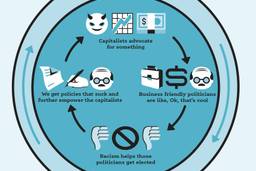
The success of Wal-Mart is in many ways paradoxical. The world’s biggest corporation – and one of the most technologically sophisticated – emerged from the poor, rural backwaters of Arkansas, a state regularly at the bottom of most state achievement rankings. Increasingly global in procurement and sales, it grew from a base that was racially homogenous – a result of the violent expulsion of African-Americans – and suspicious of all outsiders. A company that plays on “family values” is based in a region with one of the highest divorce rates in the United States. A region of low-income families adhering to a range of anti-materialist Protestant faiths gives birth to this colossus of consumerism. And the list goes on.
But as a business, it does a lot of things right, even if the social consequences are often wrong. Now, adding valuable new analyses to a growing literature on a company both deeply loved and passionately hated, two historians offer distinctive, if overlapping, accounts of what Sam Walton hath wrought. Both books are essential reading for understanding not just Wal-Mart, but also America’s general political and economic trajectory.
Nelson Lichtenstein, as indicated by his book’s title–The Retail Revolution: How Wal-Mart Created a Brave New World of Business (Metropolitan, July) – focuses on how Wal-Mart’s revolution in retail has transformed business more broadly and possibly created the paradigmatic corporation for the “post-industrial” economy, as General Motors did in the decades after World War II.
By contrast, in To Serve God and Wal-Mart: The Making of Christian Free Enterprise (Harvard, May), Bethany Moreton concentrates on the cultural revolution – or counter-revolution – that Wal-Mart fostered yet also opportunistically exploited. Wal-Mart’s patriarchal but service-oriented and religiously-tinged corporate culture not only helped it thrive in its home territory. It also gave the company an edge in exploiting the nation’s growing inequality and economic insecurity and in capitalizing on the Southernization of American politics and the rise of the Republican right.
Wal-Mart fostered both revolutions, sometimes not as a fully thought-out strategy, by shrewdly taking advantage of ideas generated by others – from the discount store model to bar codes – and by converting what seemed to be drawbacks and obstacles into opportunities. Much of Wal-Mart’s innovative success comes from its single-minded, even ruthless pursuit of some of these adopted ideas and, ultimately, from the advantages it gained from its great size.
But as it advanced economic and cultural revolutions, Wal-Mart was also nurtured by independent changes in business and society.
Frustrated by corporate constraints on his dime store operations, Sam Walton launched his chain of discount stores in 1962, a time when discounters like New York’s E.J. Korvette inspired the creation of new chains, including K-Mart, Woolco and Target. Although Arkansas had been a center of populist opposition to chain stores as a foreign threat, Walton defined his chain as local. He recognized the potential buying power in rural communities, swollen with retirees benefiting from the New Deal (from social security to local lake development, as Moreton notes). He built a distribution center with his own truck fleet (since local transportation was underdeveloped), then filled in stores throughout a day’s driving radius. Then he expanded the pattern in ever more regions.
Wal-Mart at heart was an increasingly efficient distribution company, Lichtenstein writes, and an information company, not a traditional retailer. It promoted bar codes early and used information systems to track products from point-of-sale to vendors. It minimized inventory. It also accumulated sales information to gain leverage in its tough negotiations for cheaper prices from suppliers. These vendors, like Procter & Gamble, previously enjoyed the upper hand but increasingly partnered with or became subordinate to Wal-Mart. The company seized power from the manufacturers, Lichtenstein notes, revolutionizing not only retail, but the whole economy.
Walton also gained competitive advantage by keeping labor costs low and unions out, following a union-buster’s advice to either fight his employees or get them on his side – and he did both as needed. He also was a relatively early big importer from Asia, despite his Buy American marketing. That strategy took off when Wal-Mart established its own buying office in China, subjecting producers there to the same demands for special treatment and ever lower prices.
One of the ways Walton tried to get employees – and customers – on his side was through the creation of what Moreton describes as conservative Christian “corporate populism”. Wal-Mart’s defanged populism had none of the original Populist bite against big corporate power, but retained its resentment of all that was foreign. The company created “Wal-Mart country” as home not just for poor rural whites of Arkansas but for all the working-class families that have been increasingly stressed financially since the 1970s – Wal-Mart’s “golden decade.”
Walton himself was a mainstream Presbyterian, but the corporate culture of Wal-Mart owes much to the conservative Protestantism of the Ozarks that had developed a reverence for both God and the “free market.” Walton recreated in his stores, Moreton argues, a version of the patriarchal farm family, with a largely female sales force and largely male management – a pattern now the subject of a giant class-action lawsuit.
The company promoted the model of the “servant leader,” adopted by many conservative churches, for those managers, even though the ideal of leading by serving often conflicted with the harsh methods used by Wal-Mart managers, including kindly old Mr. Sam, the father figure of Wal-Mart country. Female clerks saw themselves as serving the needs of families rather than promoting Godless consumerism.
Wal-Mart recruited store managers heavily from local Christian colleges, encouraging their programs of education in free-market fundamentalism – groups like Students In Free Enterprise – and other efforts to spread the linked gospels of Christianity and free markets. Wal-Mart supercenters and evangelical megachurches grew in tandem, and their hardcore constituents tended to vote Republican and trust more in God and Wal-Mart to solve their problems than in government and unions.
Moreton says this is not just a result of corporate manipulation and credits Wal-Mart’s women employees with shaping the corporate culture. But she also provides ample evidence of manipulation. Where the softer cultural strategy failed, she and Lichtenstein both show how hard Wal-Mart is willing to crack down. Moreton relies heavily on the testimony of Wal-Mart loyalists, who play a crucial role in the company. But half Wal-Mart’s workforce turns over annually, many voting – if not in a union election – with their feet to express discontent.
No doubt Wal-Mart’s conservative Christian corporate populism has played a big part in its success. But Wal-Mart also triumphed because of its cheap products, efficient distribution, mastery of information, anti-unionism and ability to dictate terms to vendors. But would it have become such a powerhouse if inequality had not grown so dramatically or if conservatives had not so demonized government, often with coded racial messages? Moreton’s work is important for understanding conservative and anti-union tendencies in America’s working class.
Will Wal-Mart’s model continue to work? As it spreads throughout the country, it meets widespread resistance. Its overseas ventures post mixed results. Its competitors are adopting its techniques. The cultural and demographic base on which it was built is shrinking as a portion of the U.S. population.
How could higher energy prices or Internet shopping affect its future? What changes might unionization bring? How would Wal-Mart fare in a United States with a more broad-based prosperity? The work of historians Lichtenstein and Moreton can’t answer those questions, but Wal-Mart’s current reign may not last forever (just look at General Motors). Yet, for years to come, it will remain a major force shaping the global economy – another reason these two excellent books are well worth reading.
David Moberg, a former senior editor of In These Times, was on staff with the magazine from when it began publishing in 1976 until his passing in July 2022. Before joining In These Times, he completed his work for a Ph.D. in anthropology at the University of Chicago and worked for Newsweek. He received fellowships from the John D. and Catherine T. MacArthur Foundation and the Nation Institute for research on the new global economy.









